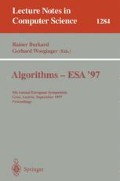Abstract
This paper shows an important exception against the common perception that three-dimensional meshes are more powerful than two-dimensional ones: Let N be the total number of processors. Then permutation routing over three-dimensional mesh computers needs Θ(N 2/3) steps while it takes Θ(N 1/2) steps over two-dimensional ones under the following condition: (1) The path of each packet must be determined solely by its initial position and destination, i.e., the algorithm must be oblivious. (2) Each path must be “elementary,” i.e., it must be shortest and as straight as possible. Thus the conditions are quite reasonable in practice, under which, little surprisingly, three-dimensional meshes are significantly less powerful than two-dimensional ones for the fundamental network operation.
Preview
Unable to display preview. Download preview PDF.
References
A. Bar-Noy, P. Raghavan, B. Schieber and H. Tamaki, “Fast deflection routing for packets and worms,” In Proc. ACM Symposium on Principles of Distributed Computing, 75–86 (1993).
A. Borodin and J.E. Hopcroft, “Routing, merging, and sorting on parallel models of computation,” J. Computer and System Sciences 30 (1985) 130–145.
S. Cheung and F.C.M. Lau, “A lower bound for permutation routing on two-dimensional bused meshes,” Information Processing Letters 45 (1993) 225–228.
D.D. Chinn, T. Leighton and M. Tompa, “Minimal adaptive routing on the mesh with bounded queue size,” In Proc. 1994 ACM Symp. on Parallel Algorithms and Architectures (1994) 354–363.
Q.P. Gu and J. Gu, “Two packet routing algorithms on a mesh-connected computer,” IEEE Trans. on Parallel and Distributed Systems, Vol. 6, No. 4 (1995) 436–440.
K. Iwama, E. Miyano and Y. Kambayashi, “Routing problems on the mesh of buses,” J. Algorithms 20 (1996) 613–631.
K. Iwama and E. Miyano, “Oblivious routing algorithms on the mesh of buses,” In Proc. 11th International Parallel Processing Symposium, (1997) 721–727.
C. Kaklamanis, D. Krizanc and A. Tsantilas, “Tight bounds for oblivious routing in the hypercube,” Math. Systems Theory 24 (1991) 223–232.
C. Kaklamanis and D. Krizanc, “Optimal sorting on mesh-connected processor arrays,” In Proc. 1991 ACM Symposium on Parallel Algorithms and Architectures, (1991) 17–28.
M. Kunde, “Lower bounds for sorting on mesh-connected architectures,” Acta Informatica, 24 (1987) 121–130.
F.T. Leighton, Introduction to Parallel Algorithms and Architectures: Arrays, Trees, Hypercubes, Morgan Kaufmann (1992).
F.T. Leighton, F. Makedon and I. Tollis, “A 2n-2 step algorithm for routing in an nxn array with constant queue sizes,” Algorithmica 14 (1995) 291–304.
L.Y.T. Leung and S.M. Shende, “Packet routing on square meshes with row and column buses,” In Proc. 1989 ACM Symp. on Parallel Algorithms and Architectures (1989) 328–335.
L.Y.T. Leung and S.M. Shende, “On multidimensional packet routing for meshes with buses,” J. Parallel and Distributed Computing 20 (1994) 187–197.
T. Nesson, Randomized, oblivious, minimal routing algorithms for multi-computers, Ph.D Thesis, Harvard University (1995).
C.P. Schnorr and A. Shamir, “An optimal sorting algorithm for mesh-connected computers,” In Proc. ACM Symp. on Theory of Computing, (1986) 255–263.
J.F. Sibeyn, M. Kaufmann and R. Raman, “Randomized routing on meshes with buses,” In Proc. European Symposium on Algorithms, (1993) 333–344.
T. Suel, “Routing and sorting on fixed topologies,” Ph.D Thesis, The University of Texas at Austin (1994).
S. Rajasekaran and R. Overholt, “Constant queue routing on a mesh,” J. Parallel and Distributed Comput., 15 (1992) 160–166.
S. Rajasekaran and T. Tsantilas, “Optimal routing algorithms for meshconnected processor arrays,” Algorithmica 8 (1992) 21–38.
M. Tompa, Lecture notes on message routing in parallel machines, Technical Report # 94-06-05, Department of Computer Science and Engineering, University of Washington (1994).
Author information
Authors and Affiliations
Corresponding author
Editor information
Rights and permissions
Copyright information
© 1997 Springer-Verlag Berlin Heidelberg
About this paper
Cite this paper
Iwama, K., Miyano, E. (1997). Three-dimensional meshes are less powerful than two-dimensional ones in oblivious routing. In: Burkard, R., Woeginger, G. (eds) Algorithms — ESA '97. ESA 1997. Lecture Notes in Computer Science, vol 1284. Springer, Berlin, Heidelberg. https://doi.org/10.1007/3-540-63397-9_22
Download citation
DOI: https://doi.org/10.1007/3-540-63397-9_22
Published:
Publisher Name: Springer, Berlin, Heidelberg
Print ISBN: 978-3-540-63397-6
Online ISBN: 978-3-540-69536-3
eBook Packages: Springer Book Archive

